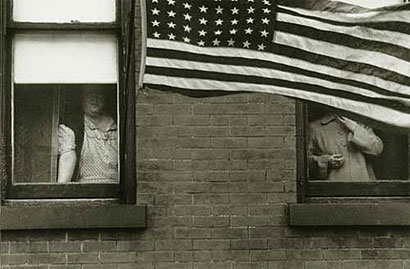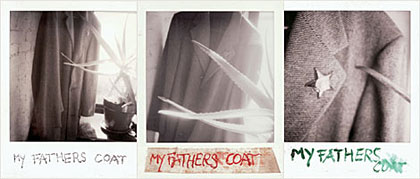| photography
Coincidences provides us with some great Robert Frank links.

Robert Frank travelled the US taking artfully empty pictures of 'the most banal things'. Photography would never be the same again, says Geoff Dyer
|
There's no getting away from Robert Frank. His influence has been felt even by people who have never heard of him or seen his landmark book The Americans. And yet, as Frank's forthcoming retrospective at Tate Modern illustrates, that book is just part of more than half a century's creative endeavour. As with Philip Roth, a considerable part of Frank's ongoing effort has been about the effects of early success. Living in the wake of his legend has been a source of dissatisfaction and resignation, as well as a goad.
| |
[more]
In search of lost time
His work captured the 20th century. But Robert Frank was really trying to make sense of his own life. By Adrian Searle
|
Towards the end of Robert Frank's exhibition Storylines, which opens this week at Tate Modern, is a hand-coloured photograph of a couple standing in a field. They could be brother and sister, or young sweethearts - perhaps even nervous newlyweds. They pose stiffly, standing erect and a little apart, with their hands hidden behind their backs. Their clothes, like the photograph itself, are indefinably old-fashioned. The style of the photograph was probably already dated when it was taken. The photo's mount has yellowed, and the grey painted border looks as sad as an old lace ribbon. The colour, which has faded unevenly, no longer seems to quite belong to the image, if ever it did. It tints the picture like the cosmetics a mortician uses to tart up a corpse.
The wall label says Untitled Found Photograph. Anonymous, Not Dated. This image is quite unlike any photograph the 80-year-old photographer and film-maker has ever taken. Except as a wistful snatch of unrecognisable history, it isn't even much of an image. Why has Frank included it in his show? It comes in the final section, Memory for the Children 2001-2003, so perhaps he was thinking of his own two children, both now dead. (Perhaps it really is a picture of them, but I doubt it.) And here is his father's coat, with a legend that tells us so, and some Polaroids over which Frank has written: Entre la Vie et la Mort (Between Life and Death). A lot of this is a bit confusing, even though we can feel the emotional jolts.
Robert Frank: Storylines is not a retrospective in the usual sense, even though it is presented as a survey of his work from the late 1940s to the present. It is something much more poetic and elegiac, and as complicated as a life itself. Frank wants to tell a story, or even several versions of it. But the story isn't over, and he is still living it. He keeps on circling his own past, his own career, like a hunter after his quarry. Much of his work has been about trying to make sense of his own life, and the loss of his daughter in a plane crash, the death of his son after years of mental illness. There's sorrow and guilt, loss and anger in Frank's work - emotions so personal that his art won't submit to the usual exhibition rubrics.
| |
[more]
The big empty
The epic loneliness of Robert Frank's photographs has made them iconic images of 20th-century America. Now 80, and on the eve of a major retrospective, he grants Sean O'Hagan a rare interview
|
It was Jack Kerouac who first defined Robert Frank's genius, who found in it some echo of his own vision of a vast, broken-down, but still epic, America, peopled with restless and lonely dreamers. 'Robert Frank, Swiss, unobtrusive, nice,' wrote Kerouac in his now famous introduction to Frank's collection The Americans , 'with that little camera that he raises and snaps with one hand he sucked a sad poem right out of America on to film, taking rank among the tragic poets of the world'.
| |
[more]
Six Reflections on the Photography of Robert Frank

|
After my father was buried in 1976 in Zurich, my mother gave me the coat: “This is your father’s coat. It is very good, warm and not worn at all. Please take it with you to New York and wear it.” I hung up the coat in a small room in our house – with all my film cans on the window sill and an Aloe plant (needs a little water). The door is closed. I did not wear the coat for many years. As time goes by I am thinking more of my father and how I might become more like him.
On 14th Street I buy a Russian Lenin medal with shining red star. The medal looks good on the coat – it changes everything. The coat stays with the plant and film cans. When I am in New York on a cold day I wear the coat with the medal. The writing under the photograph is like sending a postcard – the medal on the coat an imaginary past; the plant is alive and waiting and growing… and I am getting old.
| |
[more]
Robert Frank
Storylines
Robert Frank
Robert Frank Online |

